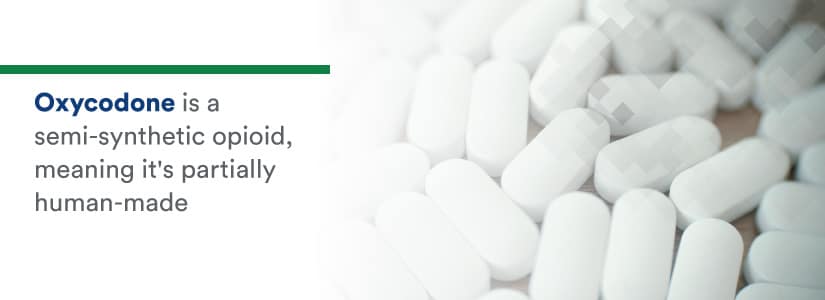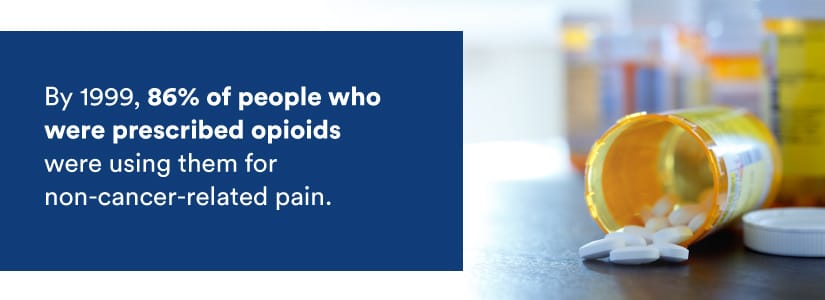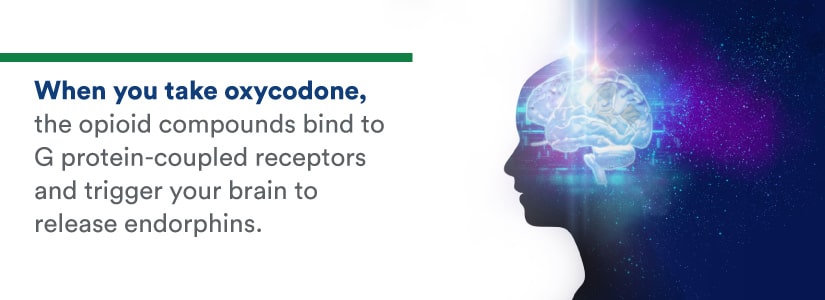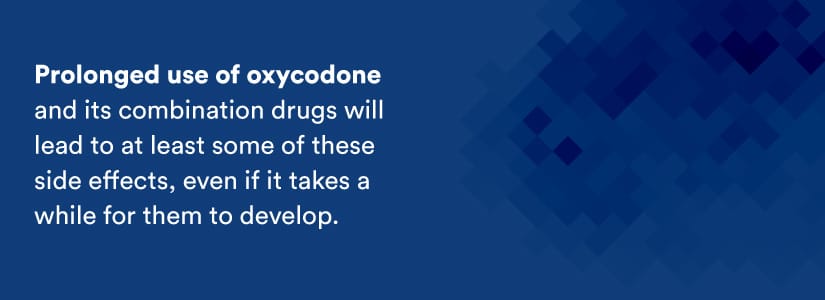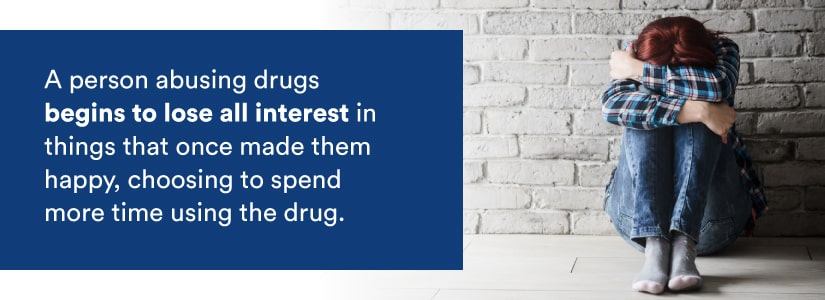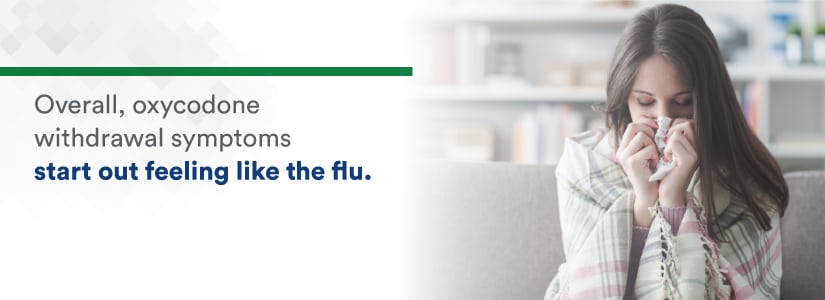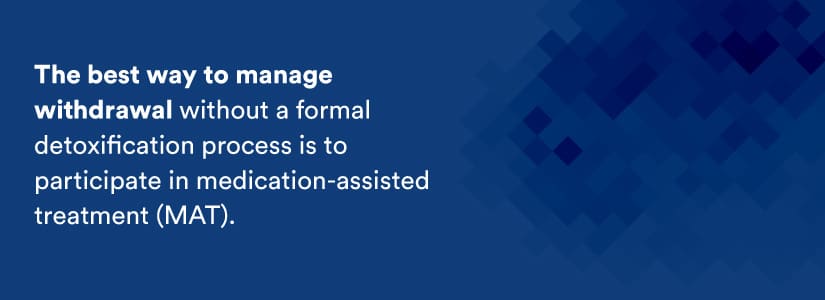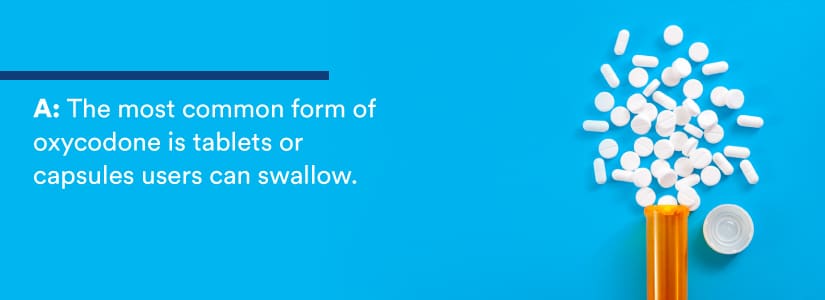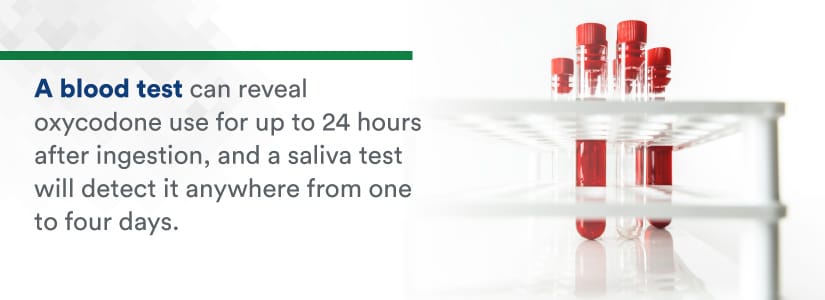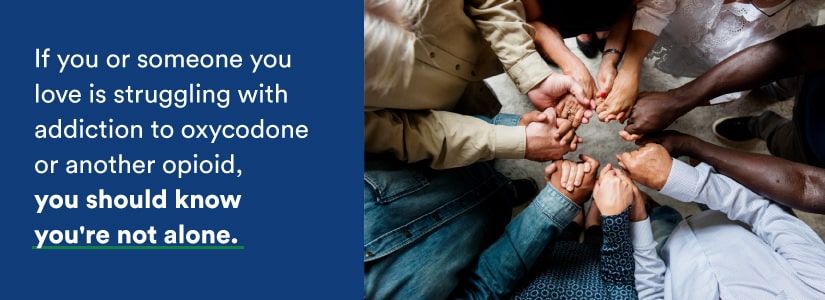It’s almost impossible to go through life without hearing about oxycodone, but most people don’t know what it is. Whether you’ve had a friend who got an oxycodone prescription after getting their wisdom teeth out, know someone who is struggling with an addiction to this medication or wonder why you’ve been hearing so much about it in the news, you have naturally have questions about it.
Understanding what oxycodone is, what it does and how it affects people who use or abuse it is key to making the best decisions for yourself and being there for others who may need your support.
What Type of Drug Is Oxycodone?
The one thing most people know about oxycodone is that it’s a type of opioid. Opioid drugs mimic the chemical structure of a natural neurotransmitter in the brain. They have similar chemical compositions that fool the brain’s receptors into accepting the opioids, and then go to work producing the “opioid effect,” which helps block pain, among other effects.
Oxycodone is a semi-synthetic opioid, meaning it’s partially human-made. The process starts with thebaine, a compound that occurs naturally in opium. It’s one of the more minor components of opium, and is similar to morphine and codeine in structure. However, rather than producing depressant effects, it has stimulatory effects. The process of making oxycodone alters the chemical structure enough to change the effects to be more depressant.
Oxycodone is a discrete medication in and of itself and comes under brand names like OxyContin®, Xtampza ER®, Roxicodone® and Oxaydo®. However, oxycodone is also an active ingredient in many combination drugs prescribed to treat pain. Drug manufacturers commonly combine it with acetaminophen, giving rise to these name-brand medications:
- Endocet®
- Oxycet®
- Percocet®
- Roxicet®
- Xartemis XR®
Combining oxycodone with aspirin creates Percodan®, and adding it to ibuprofen makes Combunox®.
Oxycodone Uses and Prescriptions
Clinical settings have used oxycodone since 1917, making it much older than many people realize. Since its invention, it has always been a painkiller — both moderate and severe, depending on the drugs it’s combined with. OxyContin comes in extended-release tablets that are intended to relieve pain for up to 12 hours at a time.
In general, oxycodone is for people who are experiencing severe, long-lasting pain that doesn’t respond to other medications. If a different medication can control the pain when taken as directed, a doctor won’t usually prescribe oxycodone or any of its combination drugs. Some of the conditions that can cause this severe pain include:
- Cancer
- Arthritis
- Fibromyalgia
- Irritable bowel syndrome
Specific injuries that cause chronic pain may warrant an oxycodone prescription as well. Often, people who work in highly physical industries develop chronic pain from constant over-exertion. Football players, for example, have been garnering headlines for their struggles with prescription opioids and addiction.
Oxycodone in the Media and Public Eye
Oxycodone began to pick up speed as a drug of choice after Purdue Pharma began marketing it as OxyContin in 1996. At first, users hailed it almost as a miracle drug for its ability to arrest pain quickly and effectively. Purdue went all-in on marketing to physicians, and distributed more than 15,000 copies of a video titled “I Got My Life Back.” The video followed six patients who took OxyContin for non-cancer pain, and encouraged the use of the drug for ongoing treatment of pain. It even highlighted a purported lack of side effects, which we now know is untrue.
By 1999, 86% of people who were prescribed opioids were using them for non-cancer-related pain, and the widespread variation in usage plus a lack of oversight started leading to widespread abuse of the drugs. The late ’90s saw the tide of public opinion begin to turn as more and more evidence mounted that opioids were highly addictive and had the potential to be fatal.
News coverage from the early 2000s up to today all focuses on the opioid crisis that has continued to unfold as a result of aggressive marketing and lax prescribing guidelines. The media continues to present coverage on opioids in the form of frightening statistics and emotional op-eds. While the opioid crisis is genuine and deserves to remain a topic of public discussion, the media depiction of opioids may vilify those who struggle with addiction and can prevent them from seeking help due to the stigma.
A High-Profile Problem for Purdue
In 2019, oxycodone, in particular, has re-entered the news cycle thanks to new revelations about the creators of OxyContin. A recently discovered email shows Dr. Richard Sackler, chairman and president of Purdue Pharma, was fully aware of the potential for OxyContin abuse, and intended to divert the blame. The email, released in a lawsuit against the company, urges:
“We have to hammer on the abusers in every way possible. They are the culprits and the problem. They are reckless criminals.”
However, the blame-shifting approach didn’t work as more and more people became addicted, and the drug continued to ruin users’ lives. It has become painfully clear that oxycodone in any of its name-brand forms or combinations is an immensely powerful medication.
Effects of Oxycodone
When you take oxycodone, the opioid compounds bind to G protein-coupled receptors and trigger your brain to release endorphins. These chemicals are part of your brain’s reward system, and play several roles in your mood and physical state. They reduce your ability to perceive pain while enhancing feelings of pleasure.
While people who take opioids as directed experience a reduction in pain, they may also experience a temporary euphoria or elevated sense of well-being. The problem is that under normal circumstances, your body makes its endorphins in response to normal stimuli like having a delicious meal or a challenging workout. They reinforce positive behaviors and motivate us to continue doing all the things that keep us happy and healthy.
However, when you take opioids over an extended period, your body reduces its output of natural endorphins. You then stop feeling such a strong positive reaction to the opioids, and must take more to achieve the same level of euphoria or pain relief. This mechanism is called tolerance, and it’s the first stop on the road to abuse and dependence.
Common Side Effects of Oxycodone
In addition to the analgesic and euphoric effects of oxycodone, there are highly unpleasant side effects that set in for the short and long term. Oxycodone and Percocet side effects are much the same, though some other combinations may alter the strength or frequency of the effects. The most common are:
- Nausea
- Constipation
- Vomiting
- Drowsiness
- Dizziness
- Itching
- Headache
- Blurry vision
- Sweating
- Dry mouth
For most people, the reduction in pain is enough to overcome most of these symptoms. However, even a minor manifestation of these side effects can affect a person’s ability to perform routine tasks like doing the dishes or completing work projects. If a person is abusing an oxycodone medication for recreational purposes, they may not even notice the side effects at all. However, this also means they may miss the more acute symptoms that indicate an overdose, such as:
- Respiratory depression or arrest
- Periodic breathing stoppage
- Circulatory depression
- Low blood pressure
- Cold sweat
- Extreme sleepiness
These symptoms may lead to a coma or death if the person doesn’t receive medical intervention in time.
Long-Term Side Effects of Oxycodone
Percocet and other oxycodone-based medications have serious side effects if taken over a long period. Some of the worst include:
- Insomnia
- Depression
- Cramping, aching muscles
- Increased spinal fluid pressure
- Limb swelling
- Heart failure
Opioids exert a strong influence over the body, and their effects touch your most vital systems. Prolonged use of oxycodone and its combination drugs will lead to at least some of these side effects, even if it takes a while for them to develop. For instance, someone may not start experiencing constipation for several weeks or months after taking Percocet. That can lead them to assume the problem stems from something else when they should be examining their use of the drug and talking to their doctor.
Signs of an Oxycodone Addiction
It’s often difficult to tell when someone is abusing oxycodone or a combination medication, even when that person is yourself. Part of the difficulty lies in the fact that most people start taking a legitimate prescription for real pain, and don’t know when their use starts to cross the line.
When you have a prescription from your doctor, it may not seem like too big of a deal to occasionally take an extra half a pill or maybe even a whole one if your pain is bad enough. And, if it really does only happen infrequently, it may not be a problem. However, if you’re concerned you or someone you care about is abusing the medication, look out for these signs and symptoms.
- Loss of interest: A person abusing drugs begins to lose all interest in things that once made them happy, choosing to spend more time using the drug. They may give up on hobbies, or stop caring about a job they once loved or a show they used to watch every week.
- Increased tolerance: If a person needs more than their original prescribed dose to experience the positive effects of oxycodone, they are at much higher risk of abusing the drug and increasing their consumption until they reach a dependent state.
- Drug cravings: Lingering thoughts about oxycodone or preoccupation with the next dose is a definite warning sign that someone is misusing it. When thoughts about the medication drift into work or family time, addiction may be creeping onto the scene.
- Drug-seeking behavior: If someone starts thinking about how to bend the rules and get more oxycodone than their doctor prescribed, or thinking about alternatives that may provide similar feelings of elation, the chances are good they are wrestling with opioid dependence.
- Social withdrawal: People who fall into oxycodone abuse often find themselves withdrawing from friends and family because they don’t want people to see any of their symptoms or struggles. They may actively push people away, or fade out of a relationship over time.
Many of the externally noticeable signs of opioid abuse, like loss of interest and social withdrawal, are challenging to identify because they are also symptoms of depression. They are also symptoms associated with chronic pain. If you’re not sure where these symptoms are coming from, you can look for physical symptoms like sweating or excessive drowsiness to validate your concern.
Signs of Oxycodone Withdrawal
Many people who end up addicted to oxycodone try to quit more than once before admitting they need help. Withdrawal happens when you’ve taken opioids long enough for your body to get used to their presence. Without opioids, your system is unable to function normally, and your body experiences unpleasant side effects as a result of the removal. Withdrawal symptoms of oxycodone are so painful and uncomfortable that a person will do anything to stop them, including going back to opioids. These are the most common symptoms:
- Restlessness
- Insomnia
- Abdominal cramps, nausea, diarrhea and vomiting
- Loss of appetite
- Elevated heart rate and blood pressure
- Rapid breathing
- Anxiety and irritability
- Chills, sweating and body aches
- Hyperventilation
- Uncontrollable yawning
Overall, oxycodone withdrawal symptoms start out feeling like the flu. A person will probably have hot and cold flashes and intense cravings for oxycodone as the drug continues to leave their system. Many individuals report severe psychological symptoms like panic and anxiety, as well as a deep sense of dread or fear.
Timeline of Oxycodone Withdrawal
Withdrawal looks a little different for everyone, and not every symptom shows up at the same time. There are a few factors that influence how withdrawal unfolds for a specific individual:
- Total length of oxycodone abuse
- Average dose of oxycodone taken
- Frequency of oxycodone consumption
- Mixing oxycodone with other drugs or alcohol
- Oxycodone consumption method
In general, people start experiencing withdrawal eight to 12 hours after the last time they ingested the drug. Symptoms are most unpleasant within the first 72 hours, and this is the time where relapse is most likely. It is also when combined symptoms present the most danger to the individual.
As an example, let’s consider someone who has been abusing oxycodone heavily for over two years. Their body has had ample time to get used to the effects of the opioid, which means their symptoms will be acute. In the first 72 hours, their symptoms may include sweating, diarrhea and hyperventilation. The combination of these three symptoms can easily lead to dehydration, which could arrest the detoxification process and reduce the chances of a successful recovery.
Reducing Withdrawals With Medication
The best way to manage withdrawal without a formal detoxification process is to participate in medication-assisted treatment (MAT). In this type of program, patients receive daily doses of methadone or buprenorphine to combat their symptoms.
These medications are opioid agonists, which means they bind to the same receptors as oxycodone and other prescription painkillers. However, they don’t produce the full effects of opioid drugs. Instead, methadone and buprenorphine trigger just enough of a response in the receptors that a person doesn’t experience the most unpleasant side effects of withdrawal.
The goal of MAT is to allow patients to feel normal while they begin the work of recovery, rather than allowing the painful symptoms of withdrawal to drive them back into opioid use. Addiction treatment professionals have used methadone in clinical settings for more than 50 years, and it is still the gold standard of treatment. In combination with therapy, MAT can give patients the best chance at a successful recovery.
Frequently Asked Questions About Oxycodone
We get many questions from concerned individuals about oxycodone and its related combination drugs. Here are five of the most common inquiries we receive.
Q: How Do People Take Oxycodone?
A: The most common form of oxycodone is tablets or capsules users can swallow. Tablets or capsules can be immediate-release or extended-release formulas. Oxycodone also comes in an oral solution. People who abuse oxycodone sometimes crush up tablets to turn them into injectable solutions — a highly dangerous and potent form of administration.
Q: How Long Does Oxycodone Take to Work?
A: You will usually feel oxycodone start to take effect within 20 to 30 minutes after taking it. Its full effects rely on reaching peak blood concentration, which takes about an hour or two. If you’re taking a controlled-release or extended-release formulation, it can take three to four hours to feel the full analgesic effects of oxycodone.
Q: How Long Does Oxycodone Stay in Your System?
A: A standard urine drug test can detect oxycodone one to three hours after taking the drug, and it can remain detectable for one to two days. This number can change depending on the severity of the abuse, as well as physical factors such as weight.
A blood test can reveal oxycodone use for up to 24 hours after ingestion, and a saliva test will detect it anywhere from one to four days. A hair follicle test will always give the longest window of detection, at up to 90 days after last use.
Q: How Strong Is Oxycodone?
A: The potency of oxycodone combination drugs depends on how much oxycodone they contain. The minimum amount of oxycodone in drugs like Percocet or OxyContin is usually 5 mg per dose, with a minimum daily intake of 20 mg. Users take immediate-release tablets every four to six hours, and extended-release formulations every 12 hours.
As an example, OxyContin tablets come in strengths of 10 mg, 15 mg, 20 mg, 30 mg, 40 mg, 60 mg and 80 mg. Only your doctor can tell you what strength is appropriate for your situation.
Q: What’s the Difference Between Oxycodone and Hydrocodone?
A: There is some confusion about the difference between oxycodone and hydrocodone. They are both narcotic analgesics and semi-synthetic opioids. One difference is a minor alteration in chemical structure: Oxycodone has one extra oxygen atom. Hydrocodone also derives from opium, but it comes from codeine rather than thebaine.
As with oxycodone, drug manufacturers often combine hydrocodone with acetaminophen and other drugs to make highly effective painkillers. At one point, hydrocodone was the most prescribed medication in the U.S., distributed through combination drugs. However, after the government reclassified the majority of hydrocodone products as Schedule II substances in 2014, sales dropped significantly. Afterward, the name-brand oxycodone drug OxyContin became more popularly prescribed.
Getting Help for Oxycodone Addiction
If you or someone you love is struggling with addiction to oxycodone or another opioid, you should know you’re not alone. Between 8 and 12% of people whose doctors prescribe them opioids develop an opioid use disorder, and the majority of them don’t get the help they need. Finding the right treatment program is easier said than done, which is why Health Care Resource Centers invites you to reach out and learn more about our addiction treatment services.
Health Care Resource Centers and our affiliate programs are throughout New England and in other areas of the United States, providing compassionate care and treatment expertise to those struggling with addiction. In addition to medication-assisted treatment, we offer multiple types of counseling, training and resources to support you or your loved one’s journey to a drug-free life.
If you’re ready to take the next step and explore opioid addiction treatment options, call Health Care Resource Centers at 866-758-7769 or visit us online.

